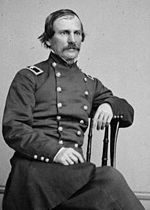William Hays (general): Difference between revisions
No edit summary |
Revert to revision 191011117 dated 2008-02-12 23:06:20 by 74.224.67.251 using popups |
||
| Line 1: | Line 1: | ||
[[Image:WilliamHays.jpg|right|thumb|150px|William Hays]] |
[[Image:WilliamHays.jpg|right|thumb|150px|William Hays]] |
||
'''William Hays''' ([[May 9]], [[1819]] – [[February 7]], [[1875]]) was a career officer in the [[U.S. Army]], serving as a general during the [[American |
'''William Hays''' ([[May 9]], [[1819]] – [[February 7]], [[1875]]) was a career officer in the [[U.S. Army]], serving as a general during the [[American Civil War]]. |
||
Hays was born in [[Richmond, Virginia]], but moved to [[Nashville, Tennessee]]. [[Andrew Jackson]] appointed Hays to the [[United States Military Academy]], where he graduated in 1840 alongside [[William T. Sherman]] and [[Richard S. Ewell]]. He as initially a [[brevet (military)|brevet]] [[second lieutenant]], and was promoted to [[first lieutenant]] in 1847, serving at various posts in the northeastern states. |
Hays was born in [[Richmond, Virginia]], but moved to [[Nashville, Tennessee]]. [[Andrew Jackson]] appointed Hays to the [[United States Military Academy]], where he graduated in 1840 alongside [[William T. Sherman]] and [[Richard S. Ewell]]. He as initially a [[brevet (military)|brevet]] [[second lieutenant]], and was promoted to [[first lieutenant]] in 1847, serving at various posts in the northeastern states. |
||
Revision as of 17:19, 25 March 2008

William Hays (May 9, 1819 – February 7, 1875) was a career officer in the U.S. Army, serving as a general during the American Civil War.
Hays was born in Richmond, Virginia, but moved to Nashville, Tennessee. Andrew Jackson appointed Hays to the United States Military Academy, where he graduated in 1840 alongside William T. Sherman and Richard S. Ewell. He as initially a brevet second lieutenant, and was promoted to first lieutenant in 1847, serving at various posts in the northeastern states.
He served throughout the Mexican-American War with the light artillery, serving alongside future Civil War artilleryman Henry J. Hunt. He was wounded at the Battle of Molino del Rey, and was subsequently brevetted to captain for Contreras and Churubusco and to major for Chapultepec. From 1853 (when he was promoted to captain) until 1854, he was engaged in the Seminole Wars in Florida, and was on routine frontier duty in 1856–60 in the 3rd and then the 5th U.S. Artillery.
As a lieutenant colonel, Hays commanded a brigade of horse artillery under Henry Hunt in 1861–62 in the Army of the Potomac, serving with distinction at the Battle of Fair Oaks during the Peninsula Campaign. He participated in the Battle of Antietam, where he commanded the V Corps Reserve Artillery. His batteries were stationed on the heights east of Antietam Creek, providing long range fire against Confederate infantry positions between the East and West Woods. He commanded the artillery of the Right Grand Division at Fredericksburg. Hays was appointed brigadier general of volunteers in November 1862 and assigned command of an infantry brigade in William H. French's division in the II Corps. He was wounded and taken prisoner at Chancellorsville on May 6, 1863, along with all but one of his immediate staff.
Hays was exchanged on May 15, 1863, and sent to Fort Monroe in Virginia. He finally rejoined the army at Gettysburg, Pennsylvania, shortly after the Battle of Gettysburg. With the wounding of Winfield S. Hancock during Pickett's Charge, Hays (although still a brigadier general) temporarily commanded Hancock's II Corps throughout the summer until permanent command was given to Gouverneur K. Warren in mid-September. In November, Hays was appointed provost marshal of the southern district of New York, and was also promoted to major in the regular army.
At the expiration of his term in February 1865, Hays rejoined the Army of the Potomac at Petersburg and served again in the II Corps, this time commanding the Second Division. He was brevetted brigadier general in the regular army on March 13, 1865, for gallant conduct, but on April 6 he was relieved of command for sleeping on duty, and his brevets were revoked. From that date, he commanded the Artillery Reserve of the Army of the Potomac until he was mustered out of volunteer service in January 1866.
Reverting to his permanent rank of major of the 5th U.S. Artillery, Hays served on various posts, commanding Fort Independence in Boston Harbor from April 1873 until his death there almost two years later. He was buried in Yonkers, New York, but was reinterred at West Point Cemetery in 1894.
